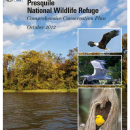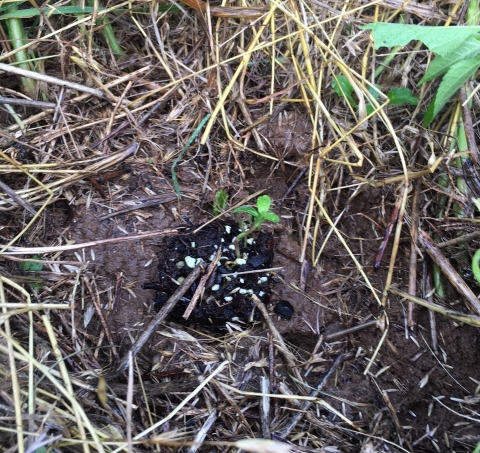What We Do
The refuge manages its forests and wetlands through a variety of different methods. Mechanical removal, mowing, prescribed burns, and herbicide applications are used to restore and maintain the integrity of these habitats. Tree planting is utilized to promote restoration of forest lands.
Management and Conservation
Refuges deploy a host of scientifically sound management tools to address biological challenges. These tools span active water management to wilderness character monitoring, all aimed at ensuring a balanced conservation approach to benefit both wildlife and people. At this field station our conservation tool box includes:
Planning – Comprehensive Conservation Plan
The purpose of a comprehensive conservation plan (CCP) is to specify a management direction for the refuge for the next 15 years. The goals, objectives, and strategies for improving refuge conditions—including the types of habitat we will provide, partnership opportunities, and management actions needed to achieve desired conditions – are described in the CCP.
Natural Resource Management
The refuge manages its wetlands, forests, and grasslands with a variety of methods. Intensive (mechanical and chemical) and passive (successional and planting) treatments are used to restore and maintain the integrity of these habitats. Through inventory and monitoring, the refuge is able to be knowledgeable of and responsive to threats from non-native species, climatic changes, and outside pressures. Protection of resources of concern are a priority, given their elevated status. Management for those species include time of year restrictions, limited access, and monitoring.
Habitat Restoration
Direct management attention to protection and restoration of the ecological integrity, diversity, and sustainability of key habitat types (forested and emergent wetlands and mature and transitional mixed mesic forest.)
Cultural Resource Management
As a federal land agency the refuge has the important responsibility to protect and conserve cultural resources and landscapes. Protective measures include strict regulations prohibiting relic hunting, limited public access, and erosion control. The rich history of the site offers opportunities for authorized professionals to build knowledge and interpret to a larger audience.
Our Projects and Research
Prothonotary warbler research (VCU)
Presquile NWR has a long history of working with Virginia Commonwealth University professors, graduate students, and undergraduates. Large-scale research has included monitoring of prothonotary warbler populations within the interior creeks of the island. This avian species is experiencing population declines nationally, but has shown increases locally when nest boxes, construct to prevent predators, are installed. The nest box program was initiated on the property for over 20 years. VCU’s research has also shown that arrival dates of the neotropical migrants have trended to an earlier arrival (possibly attributed to warming temperatures or changing food source availability). Atlantic Sturgeon population studies have also occurred as part of the University’s connect to the wildlife refuge.
Milkweed monitoring and population surveys (FWS)
Native milkweed is an important plant for pollinating insects (bees & butterflies). No species is more dependent on it for it’s life cycle than monarch butterflies. The invertebrate uses it not only to gather nectar, but also for a place to lay eggs for the next generation. Presquile NWR has a healthy population of native common milkweed on the island, but it is largely concentrated to the southern portions. New mowing techniques and a recent planting project has attempted to expand the flowering plants along the upper trail corridors of the site. In the last several years, surveys have shown plants in areas that had not supported milkweed prior
Sensitive Joint Vetch surveys (Virginia Department of Conservation & Recreation- Natural Heritage)
The wetlands on and adjacent to Presquile NWR support a rare non-descript plant. Few places are such that conditions are just right for successful populations of the Sensitive Joint Vetch. The tidally-influenced marshes and protected locations help the plant to thrive. The Sensitive Joint Vetch plant is appropriately named due to it’s particular needs for survival. The species is Federally threatened, but maintains a population on the refuge and surrounding wetlands. The Virginia Department of Conservation and Recreation’s Natural Heritage program conducts surveys at new and historically successful sites to ensure the species does get designated as endangered (the next and most critical stage before a species goes extinct).
Shoreline Erosion Control (Riparian Buffer Planting)
The wildlife refuge boundary is fully surrounded by water. The constant tidal flow, high water associated with storm events, and sandy soils cause the banks of the island to periodically erode. In an effort to curb this lose of sediment and prevent from it entering the river we have planted over 25 acres along a narrow (300 foot) corridor along the southwest corner of the refuge. Initiated in 2006, the planting project utilize volunteers, partners, and staff to plant 18 native species of trees. The planting required significant up-front labor to ensure the successful growth of the newly planted saplings.
Native Tree Nursery
The refuge has been converting former agriculture fields back into native forest since 2003. The 250-acres is now transitioning through natural succession and strategic plantings of target species. This planting requires a ready source of saplings. Therefore in 2011 a unused portion of the equipment shed was repurposed to serve as a tree nursery. Seeds from area trees are annually collected and planted in the raised beds. Once sprouting occurs, they are converted to small pots and either replanted in ground beds or taken to the appropriate sites on the refuge for permanent planting. The small nursery utilizes a unique gravity-fed water source to irrigate the plants.
Invasive Species Management
Several non-native plants species have found their way to the soils of the wildlife refuge. The invasive species invasive species
An invasive species is any plant or animal that has spread or been introduced into a new area where they are, or could, cause harm to the environment, economy, or human, animal, or plant health. Their unwelcome presence can destroy ecosystems and cost millions of dollars.
Learn more about invasive species of highest concern currently are Johnsongrass, Stiltgrass, and Japanese privet. Each species require a unique type of treatment depending on it’s life cycle and habitat preferences. Treatment methods come from a variety of techniques- mechanical, chemical, biological. Within the last several years a number of non-native species have been greatly reduced due to our efforts. Species such as tree of heaven, mimosa, and Canada thistle are largely kept in check and now are only occasionally seen on the property.
Law Enforcement
Please report all wildlife crimes by calling 804-829-9020 or contact the Department of Game and Inland Fisheries at 800-237-5712. Please provide as much information on the crime as possible. You may remain anonymous.
Laws and Regulations
Access to the island is to occur in concert with refuge sponsored public events or by Special Use Permits
- Only authorized wildlife dependent recreation activities may occur. These include: wildlife observation, nature photography, environmental education, and interpretation.
- Visitors must stay on designated trails. Pets are prohibited from entering the refuge.
- Ensure resources are not impacted from your visit. Avoid disturbance to animals, plants, and natural history items. Collecting and removing any of these items is prohibited.
- Searching for and/or collecting artifacts whether on the surface or subsurface (digging) is strictly prohibited. Stiff penalties, even imprisonment, can result from such action.

